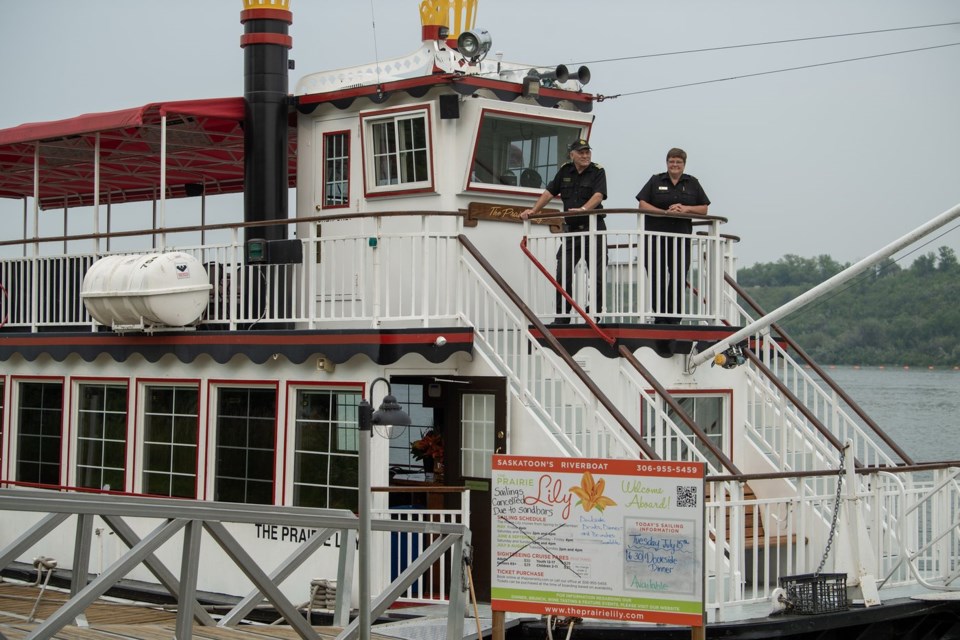SASKATOON — The owners of Saskatoon's landmark riverboat were planning to weigh anchor one final time this year, but they've been blocked by sandbars.
It’s a story Mike and Joan Steckhan say goes far beyond boats and tourists.
The couple operate the Prairie Lily on the South Saskatchewan River and say it's not how they wanted to bid farewell.
"The last year, with the river down and sand up, it's been a nightmare," Mike Steckhan, the craft's captain, said in a recent interview while on the boat.
"We just have to cope."
He and his wife plan to retire this year and have put the 119-passenger vessel up for sale. There's been some interest, but they're still trying to find the right buyer to take over in time for the next summer season.
The Prairie Lily, a popular attraction among locals and visitors, has operated in Saskatoon for 13 years. It has offered sightseeing excursions, dinner and brunch cruises, wine tastings, private events and the best seats to watch an annual fireworks festival in August.
This year, the boat is staying ashore.
There are still food services dockside, but its fireworks cruise — the owners' planned goodbye voyage — has been cancelled.
Steckhan said low water levels have prevented the boat from operating. Silt has built up in the river over the last few years and sandbars have emerged. "(The river) is mostly ankle deep, that's how much silt is in there," he said.
The low levels are also harming wildlife: beavers have left and fish are dying, he added.
"There hasn't been enough deep channels (for the fish to swim into) where they're comfortable," he said. "I've been seeing more and more dead fish belly up, floating downstream simply because they were heated. They cooked."
Steckhan argued the Water Security Agency, run by the provincial government, needs to release more water from the upstream dam at Lake Diefenbaker to flush out the river.
He said a flush every two to three years in the past helped keep the ecosystem healthy.
"In the last five years — low water or high water from the Rocky Mountains — we haven't got the flush," he said. "You start wondering, where's the water going?"
The water agency's website says Lake Diefenbaker, a reservoir used for drinking water, irrigation, industrial purposes and recreation, has been low this year due to hot and dry conditions. It also says demand for irrigation in southern Alberta, upstream of the lake, remains high.
Agency CEO Shawn Jaques said there's not enough water to flush the river.
"(A flush is) equivalent to eight years of Saskatoon's water usage in three days," he said. "I empathize with the business owners, I understand that, but it isn't the right use of water."
He added a flush may not completely remove sandbars, and he disagrees ecosystems are being harmed.
"We have professionals that study aquatic habitats and health. I don't have that information handy, but there's still fish populations in the river," he said.
Mike Steckhan said he met with agency officials and pitched a compromise.
"I asked them ... ‘Have you stopped irrigation until the lake recovers? Have you stopped hydro production until the lake recovers?’ The answer was, no and no," he said.
"The next question was, ‘Will you stop?’ And the answer was, again, no."
Jaques said the agency won't cut off irrigation.
The province is planning to expand its irrigation network to provide water from the reservoir to thousands more hectares by 2030. Jaques said there's enough water for the plan.
Joan Steckhan, the Prairie Lily's purser, said a healthy river also has value.
"It's not that we're against irrigation. We're in favour of sharing a natural resource," she said. "The frustrating point is this complete lack of recognition that this is a cumulative problem. It will not go away."
A similar story is unfolding in northeast Saskatchewan, added her husband.
He said the Saskatchewan River Delta is ecologically deteriorating, because it's not getting the water it needs. Cumberland House Cree Nation has sued the province over the issue, arguing upstream industrial and farming activities have hurt wildlife and infringed on treaty rights to protect ways of life.
The North and South Saskatchewan rivers feed the delta.
"All the silt that we're sitting on here, stopping this ship from navigating and screwing up the environment, is the exact silt they need in Cumberland House, because that's the fertilizer," Mike Steckhan said.
This report by The Canadian Press was first published July 19, 2025.
Jeremy Simes, The Canadian Press




